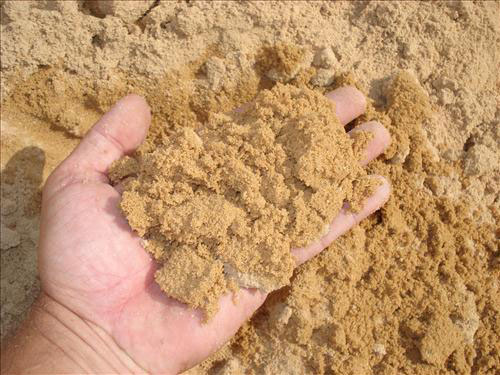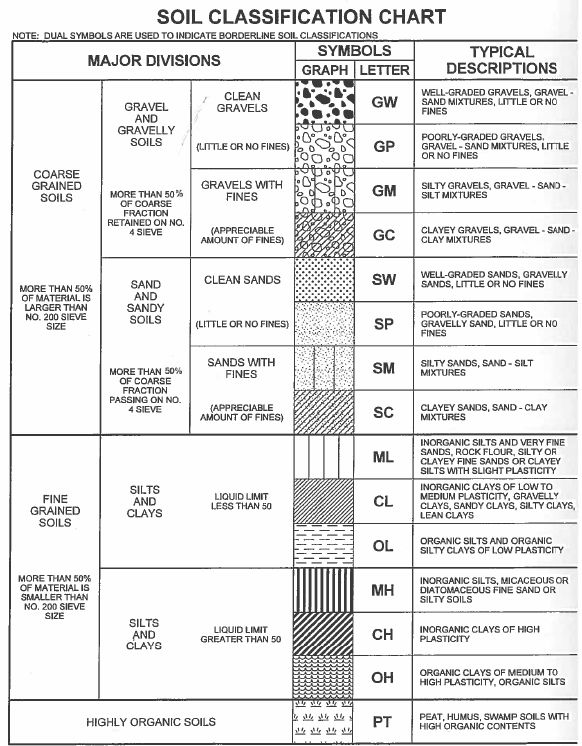Soil is classified so it can be more easily understood and utilized in the planning stage. Soils are classified by:
-Particle size
-Presence of organic content
-Sensitivity to moisture content
Generally speaking there are two major types of soils:
-Fine grained, Cohesive soils :
SILT (0.005mm than 0.075mm) and CLAY (0.075mm to 0.075mm to the negative tenth degree)
-Coarse grained, Non-Cohesive Soils:
SAND (0.07mm to 4.75mm) and GRAVEL (larger than 4.75mm)
In addition to soil classification, soils may also be identified by whether or not they are ‘confined’. Confined soil is densely packed with little space between particles and lends itself to better shear strength and bearing capacity, independent of the soils independent bearing capacity. Unconfined soils are more loosely packed and are generally more unstable. These unconfined soils relying on internal strength alone for bearing capacity and shear strength are often called frictional or cohesionless soils. The combination of coarse-grained soils which are securely confined is generally the ideal shear strength and frictional resistance condition.
CLAY
Clay is generally composed of much smaller particles than silt, with the particles being more of a platelet shape than round or square. Clays are hard when dry and
moldable/plastic when moist. Clays have a higher ‘Liquid Limit’ than coarse-grained soils, which is the moisture threshold at which the material becomes essentially’
flowable’.
Clay soils are often ‘expansive’ or more prone to expansion/contraction when exposed to moisture content and freezing/thawing. The most susceptible clays to this
behavior are those with small particle size and high liquid limits (fat clays). Expansive soils can increase as much as 10% in volume with increase in moisture content.
Clay soils can present challenges under structures and pavements. High moisture clay can have water pressed out of it from pressure above causing a phenomenon called
‘consolidation’ occur which can contribute to excessive unanticipated settlement.
Hard, over-consolidated clays can appear to be stable when excavated but may have cracks or fissures which are shear points for sloughed chunks which may unexpectedly
fall.

SILT
Silts are a cohesive soil when a certain moisture content exists and are generally non-cohesive when dry. They exhibit similar characteristics to clay but often to a
lesser extent. Slightly moist Silts can generally hold their shape during excavation considering their higher shear strength.

SAND
Sand has larger particles than silt and clay but smaller particles than gravel. It is a well draining soil making it resistant to consolidation and frost heaving. Sand is considered a fair to good subgrade for foundations and pavements, so long as it is well-confined and moderately moist when virgin, or well compacted and moderately moist when used as fill/embankment. Sand can harbor pockets of groundwater or moisture in multi-strata soils which are surrounded by silty/clay. Sand is considered unstable in terms of trench safety and stability, especially when it’s overly saturated and relatively unconfined.

GRAVEL
Gravel is the classification with the largest particles. It is a well draining soil making it resistant to consolidation and frost heaving. Gravel is considered a good subgrade ad base for foundations and pavement, so long as it is moderately moistened and well compacted. Gravel can harbor pockets of groundwater or moisture in multi-strata soils which are surrounded by silty/clay. Virgin gravel soils are considered unstable in terms of trench safety and stability because of the lack of cohesive particles.

Loam is effectively a sort of mixture of all 3 major soil types.
The following is a classification pyramid based on the makeup of a soil:

Below are soil types as characterized by the American Standard of Testing Materials:
TYPE I
Crushed Rock
TYPE II
‘Clean, coarse-grained soils’
GW – Well graded gravel, gravel sand mixtures, little or no fines
GP – Poorly graded gravel, gravel sand mixtures, little or no fines
SW – Well graded sands, gravely sands, little or no fines
SP – Poorly graded sands, gravely sands, little or no fines
‘Coarse grained soils, borderline clean to with fines’
GW/GC & SP/SM – Sands and gravels which are borderline between clean and ‘with-fines’
TYPE III
‘Coarse-grained soils with fines’
GM – Silty gravels, gravel/sand/silt mixtures
GC – Clayey gravels, gravel/sand/clay mixtures
SM – Silty sands, sand/silt mixtures
SC – Clayey sands, sand clay/mixtures
‘Inorganic fine-grained soils’
ML – Inorganic silts and very fine sands, rock flour, silty or clayey fine sands, silts with slight plasticity
CL – Inorganic clays of low to medium plasticity, gravely sandy or silty clays; lean clays
TYPE IV
‘Inorganic fine-grained soils’
ML – Inorganic silts and very fine sands, rock flour, silty or clayey fine sands, silts with slight plasticity
CL – Inorganic clays of low to medium plasticity, gravely sandy or silty clays; lean clays
TYPE V
‘Inorganic fine-grained soils’
MH – Inorganic silts, micacious or diatomaceous fine sandy or silty soils, elastic silts
CH – Inorganic clays of high plasticity, fat clays
‘Organic soils or highly organic soils’
OL – Organic silts and organic silty clays of low plasticity
OH – Organic clays of medium to high plasticity
PT – Peat and other high organic soils

A soils ability to support loads depends primarily on shear strength which is defined as partical friction resistance to internal sliding. In anticipation of buidling
construction, it is a universal engineering principal that structures will settle to some extent. This settlement should be designed to be uniform as opposed to
‘differential’. A Geotechincal Investigation and report help the building engineer understand and plan for this settlement.
Allowable foundation pressure is measured in ‘pounds per square foot’ and measures the design strength of a soil type. The following can generally be expected for allowable bearing pressure:
GW/GP – 3,000 PSF
SW/SP/SM/SC/GM/GC – 2,000 PSF
CL/ML/MH/CH – 1,500 PSF
The Water Table refers to the elevation where soil is typically fully saturated. This can be a misleading however as seasonal weather changes can cause groundwater
levels to fluctuate and also cause water to perch in pockets of coarse-grained soils, above and in between fine-frained soil stratas.
Soils are also classified by OSHA as per the following:
Type A – Cohesive soils with an unconfined compressive strength of 3,000 lbs/sf or higher. Examples: Clay, silty clay, sandy clay, clay loam. However factors
disqualifying Type A classifications are; fissures, subject to vibration (heavy traffic, pile driving, equipment, etc), previously disturbed soil.
Type B – Cohesive soils with an unconfined compressive strength of 1,000 lbs/sf to 3,000 lbs/sf or:
– Granular cohesionless soils including: crushed gravel, silt, silt loam, sandy loam
– Type A soil that is fissured.
Type C – Cohesive soils with an unconfined compressive strength of 1,000 lbs/sf or less or:
– Granular soils: gravel, sand, loamy sand
– SUbmerged or seeping soil
– Submerged unstable rock
OSHA classifies these soils for the purpose of setting slope/bank requirements during excavation:
– Type A soils 20′ deep and less can be sloped to 3/4 (horiz) to 1 (vertical) max. Example: 20′ deep excavation – edge of bank will be 15′ horizontal and 20′ vertical
from bottom of excavation to edge of bank at top of excavation.
– One exception is for ‘simple slope’ excavations 12′ deep max or less and open 24 hours or less can be sloped back at a 1/2 (horiz) to 1 (vertical) ratio.

– Type B soils 20′ deep and less can be sloped to 1 (horiz) to 1 (vertical)

– Type C soils 20′ deep and less can be sloped to 1-1/2 (horiz) to 1 (vertical)

These OSHA benching/sloping requirements are general in nature, have more complex requirements as the trench type changes, must be adjusted for strata/OSHA class
variances, and are subject to change by OSHA.
